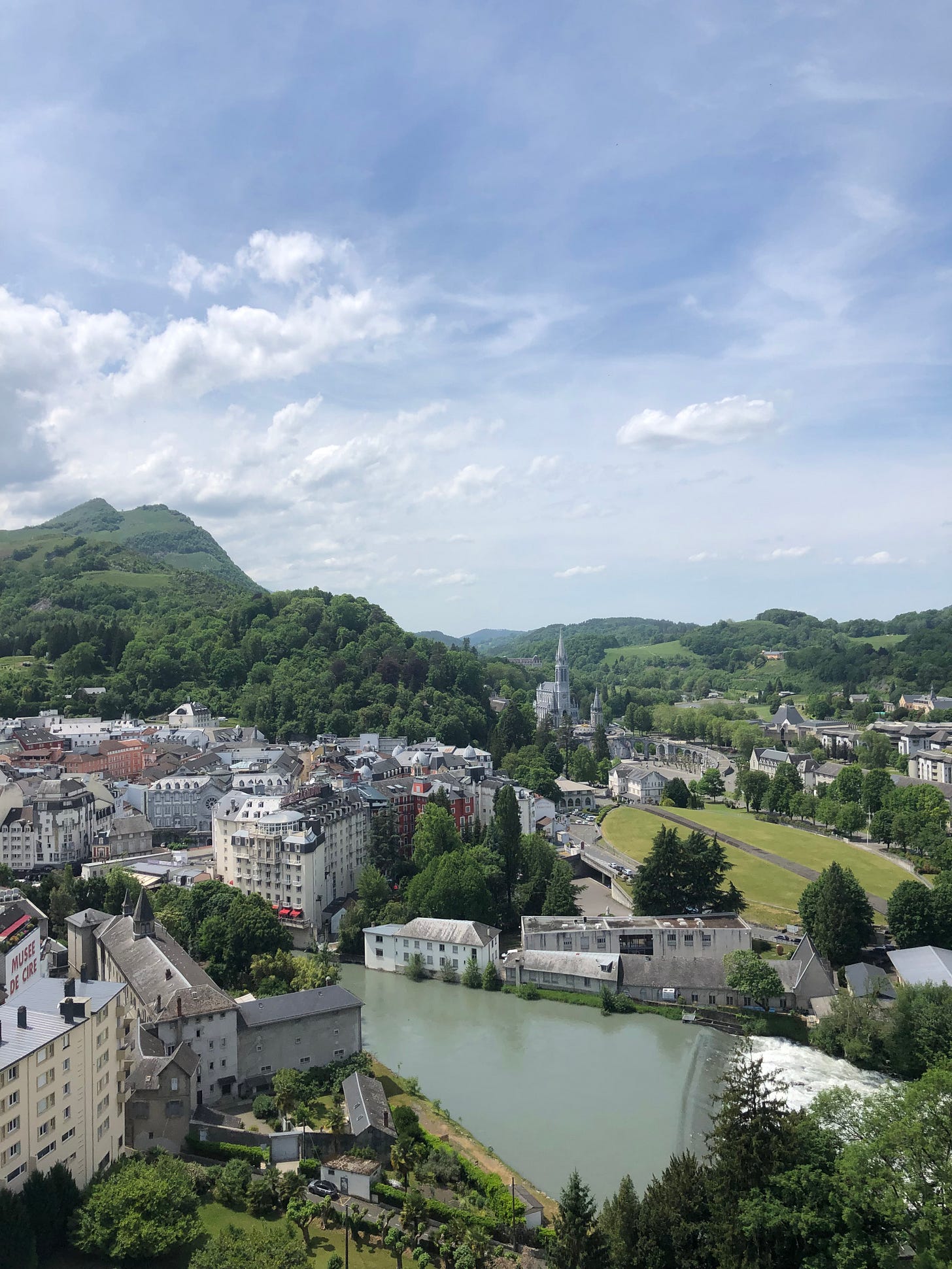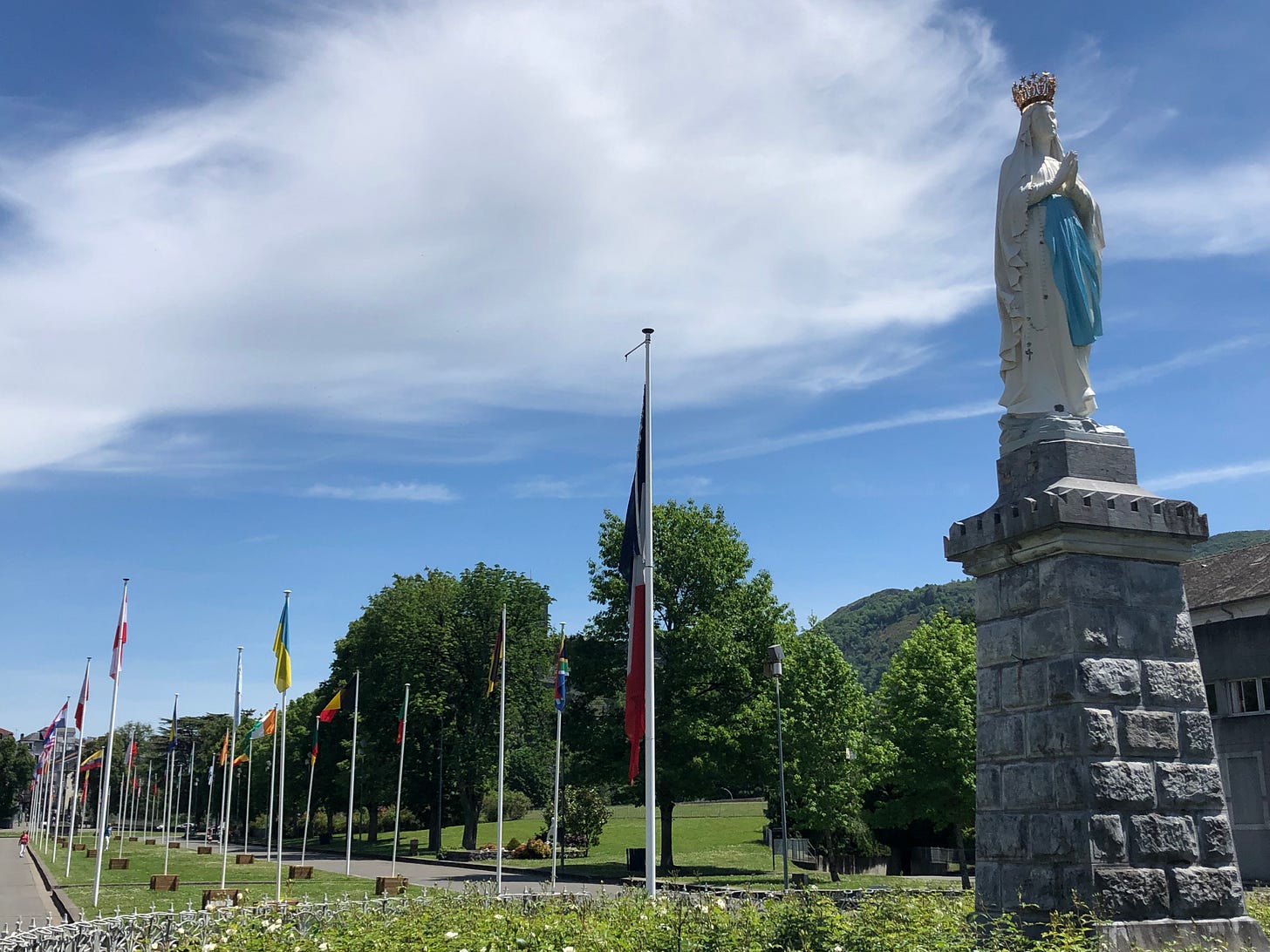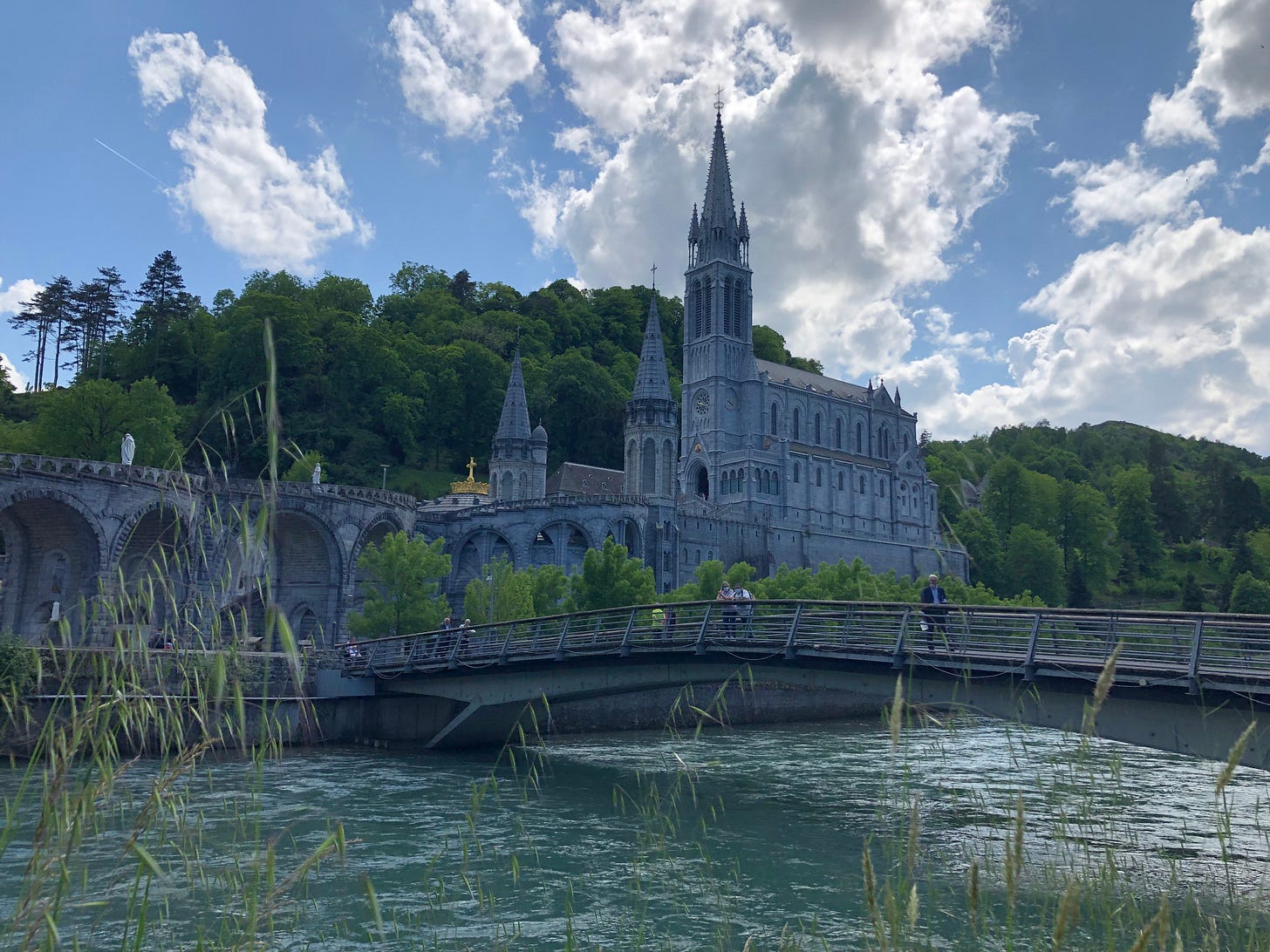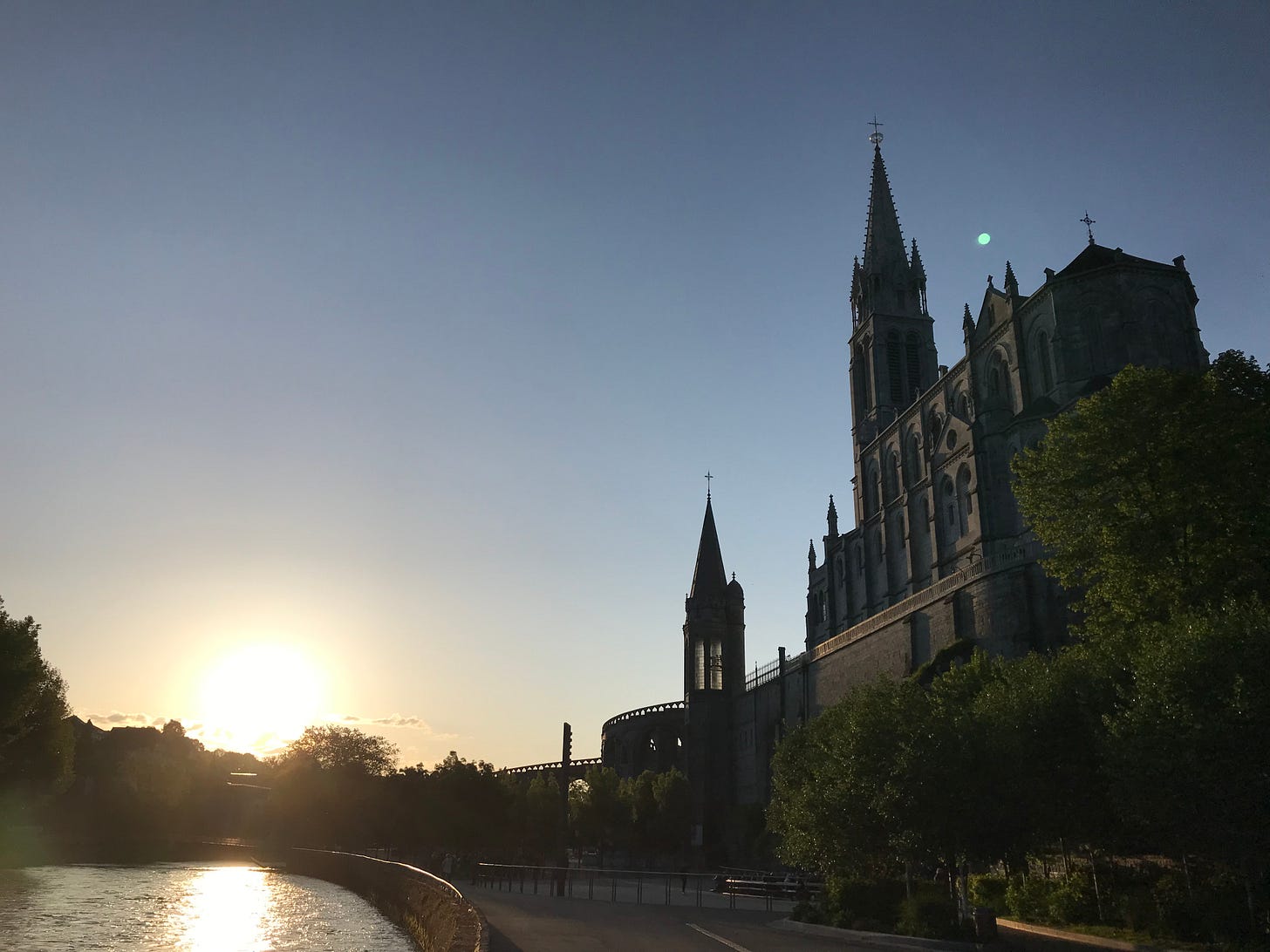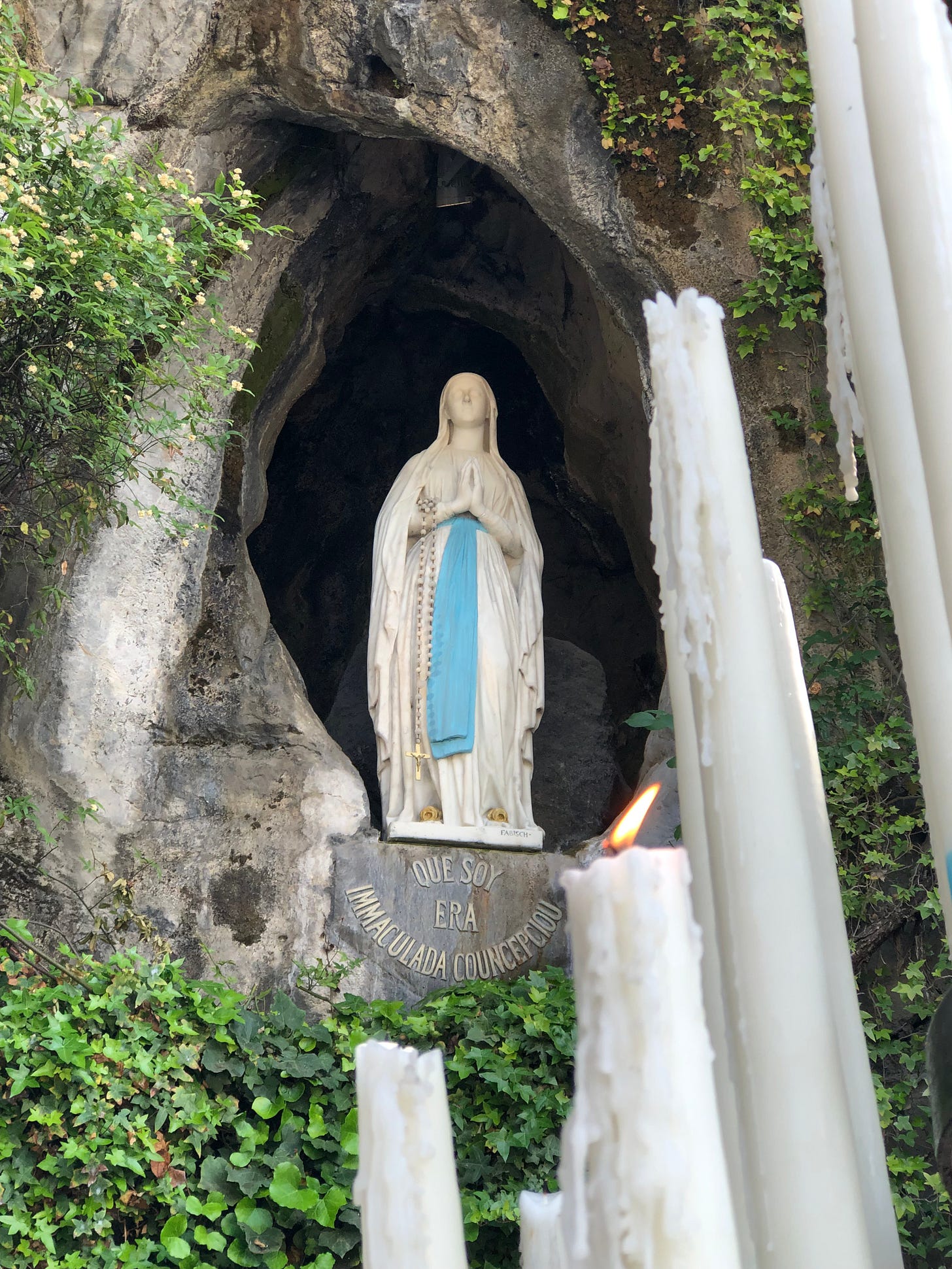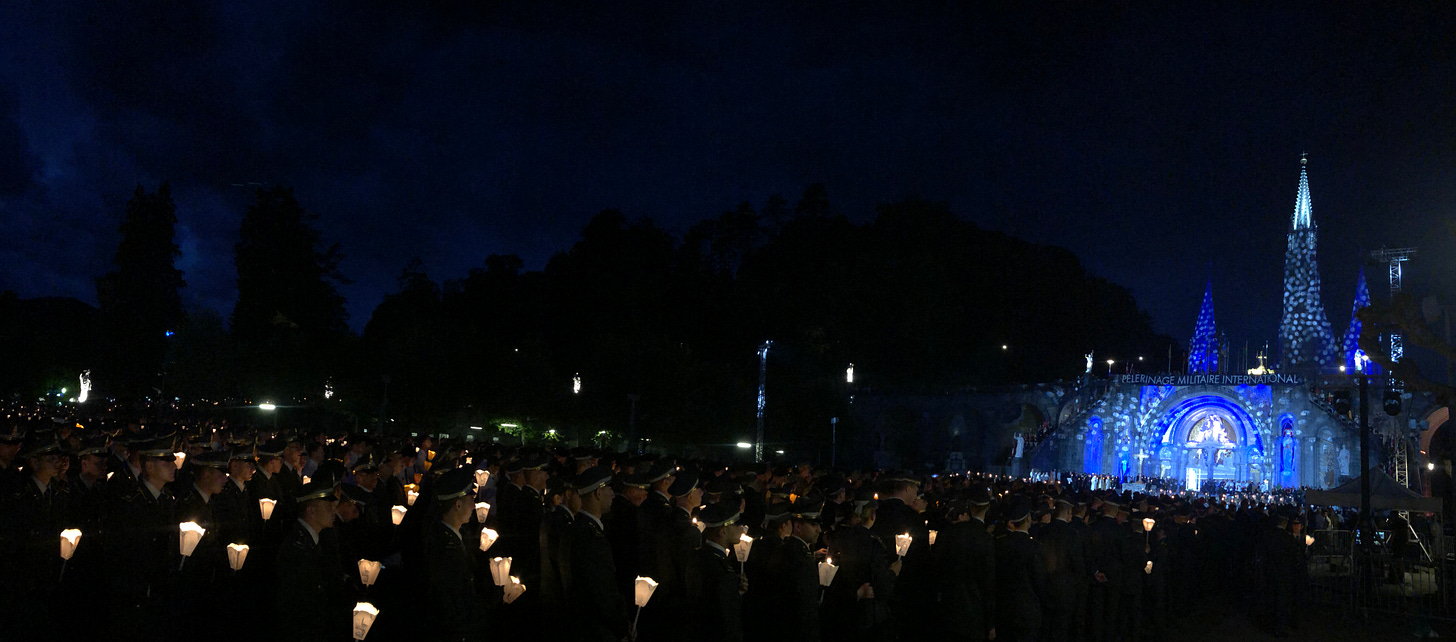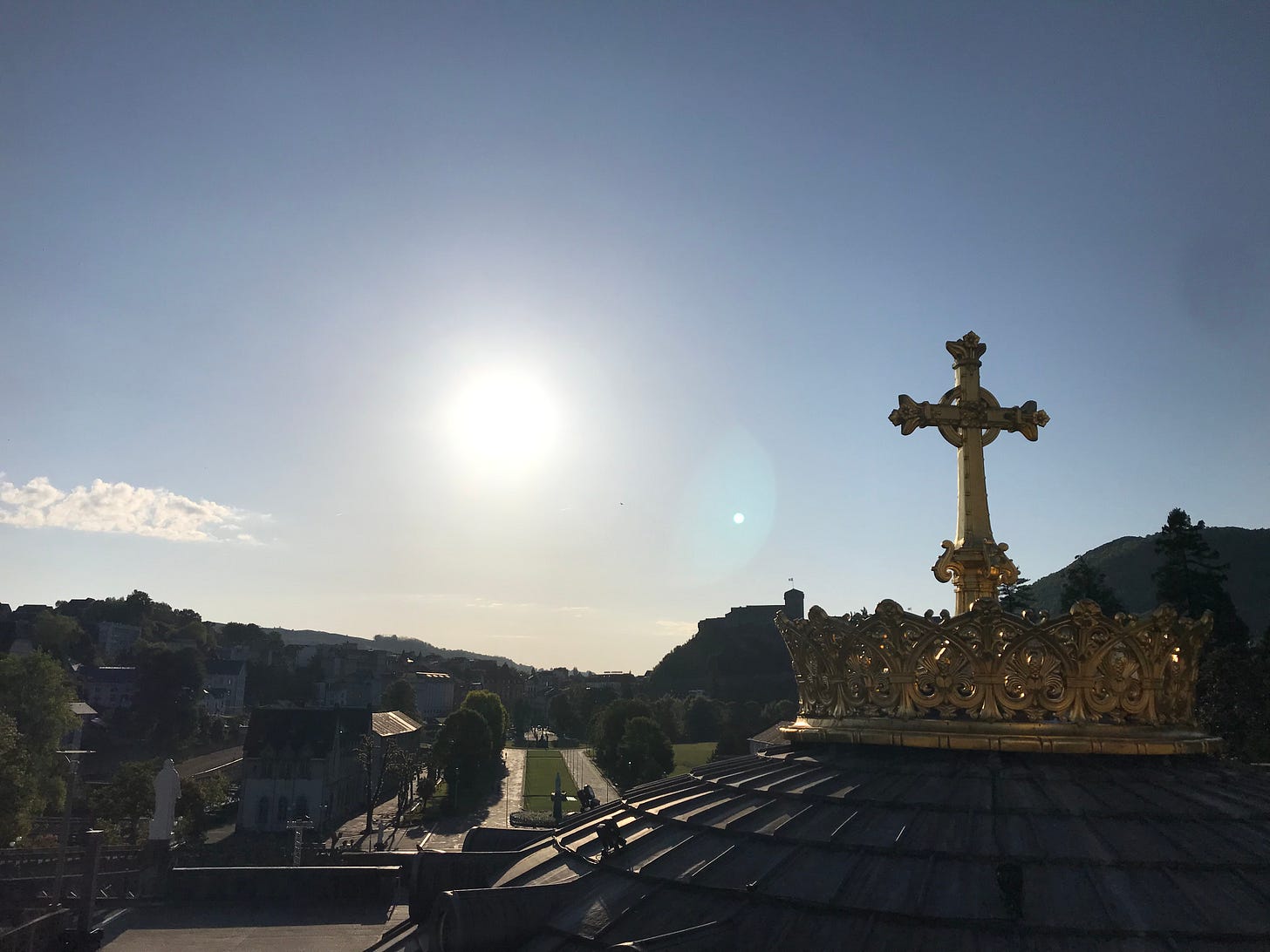Nestled on the foothills of the Pyrenees resides a fortress — dating back nearly one thousand years ago — strategically built on a hill peak with views through the valleys in every direction. Today, the fort is a museum dedicated to preserving Pyrenean culture, but the views remain the same. If one walks out onto the terrace, the entire city of Lourdes, France, can be seen. To the east, there is Lourdes-proper with office buildings, homes, a train station and even a few churches. To the west, there is the Ousse River, which weaves through the city, passing alongside the most visible landmark — the Sanctuaries of Notre-Dame de Lourdes. This landmark is a collection of basilicas, honoring the request of Our Lady of the Immaculate Conception, who commanded a chapel be constructed on the site to the 14-year-old peasant girl, Bernadette Soubirous in the mid-19th century.
Every year, millions of pilgrims journey to this city to pray, touch, and retrieve water revealed by Our Lady from the Grotto in the rock of Massabielle that has miraculously flowed on ever since. If one enters the Grotto, this spring is encased behind a protective shield with bouquets of flowers placed in front as a sign of goodwill. Thousands have claimed miraculous healings from the waters. Nearly seventy have been recognized by the Catholic Church.
But all of this looks insignificantly small from the bird’s eye view of the fort. One can’t even see the Grotto. And if we try to see from the eyes of God, the view is even infinitely smaller. So it raises the question: why, in His providence, did God ask Our Lady to appear to a shepherd girl — who was not as academically or perhaps even spiritually qualified as the clergy or religious — in this once quaint mountain village?
It’s a question that I have contemplated even prior to my own pilgrimage to Lourdes, a trip I could only have done through my work at the Knights of Columbus.
I was assigned to cover the 8th annual Warriors to Lourdes, which is a program the Knights sponsor, in partnership with the Archdiocese for the Military Services, USA, to shepherd U.S. military personnel suffering from visible and invisible wounds of war to its healing waters. The pilgrimage focuses on moral injury — which is described as an injury to a person’s conscience after an act of perceived moral transgression. The argument is that there is a difference between post-traumatic stress disorder and moral injury, in that the former relies on more physical stimuli to provoke a negative reaction, while the latter is a complete severance from one’s spirit. In the program, the pilgrims are encouraged to share their active-duty experiences in an effort to bring comfort and fraternity, while dismantling the barriers of self-isolation.
Lourdes has been the site of military pilgrimages since the end of World War I, but it became a focal point after veterans from opposing sides in World War II gathered as a sign of solidarity. This tradition has carried on in the annual International Military Pilgrimage, which recently concluded its 62nd year.
When I first began at the Knights of Columbus in June 2018, the Warriors to Lourdes program stood out as an admirable endeavor — and one that ties into the patriotic principle of the fraternal organization. Providing healing to those who sacrificed for our security is a necessity, and our duty as civilians to our men and women in uniform. Therefore, when I was asked to join this year’s pilgrimage, I was elated. It had been nearly a year since I traveled for work — the prior being a pilgrimage to South Dakota to promote the cause of Nicholas Black Elk — and several years since I journeyed outside the United States.
And I was drawn to Lourdes. I remember watching the story in a cartoon movie called Bernadette: The Princess of Lourdes as a child; and after two years of suffering from mysterious, physical ailments of my own — most likely caused by deep anxieties compounded by the pandemic — I believed I could find healing along with other pilgrims. Perhaps even a miraculous conversion of the spirit.
But before I even entered the holy city, there was a Warriors to Lourdes staff member, who has journeyed to Lourdes numerous times, who said to me, “This trip will change you.” I had a feeling it would.
My travels were between May 7-18. Prior to my arrival — even before the plane took off from John F. Kennedy Airport — I already met a member of the Warriors to Lourdes’ medical staff, a 20-year-old nursing student from upstate New York. Immediately, we became friends to the point where I felt like we had known each other our entire lives. This was a theme repeated over and over again with nearly every person I encountered throughout my time in Lourdes: the shopkeeper adjacent to the hotel, who showed me such kindness on my first day after I didn’t have enough change to purchase rosaries (I paid her back!); this welcoming group of ladies from Manchester, UK, who I bumped into nearly every single day; an Italian cadet named Francesco who sacrificed his night with comrades to assist our party in finding a friend whose phone died; as well as the staff and pilgrims themselves, who openly shared their stories with me — a petite French woman who bittersweetly chronicled how she found the love of her life (her husband passed away a few years ago); a major general in the U.S. Army who shared his emotional experience in the healing baths with his family; a colleague who revealed the tragic loss of their first-born child; and a veteran who reconnected with his brother after 20 years and his recovery from a pain-killer addiction.
These were only a few of the stories shared to me and, if I’m being honest, without much prompting. There is a vulnerability here. Everyone comes to Lourdes with a cross, and prayers asking Our Lady to lighten our burdens or the burdens of loved ones. People need a listening ear. I came here with the same intentions, but to do my job first and foremost.
But even as a member of the staff, I was swept into the role of a pilgrim. I believe everyone else was as well. I believe it’s unavoidable. On the first morning, after a nearly sleepless night, I decided to go visit the Grotto by myself. When I travel, I tend to like exploring cities and towns alone — and I’m not sure as to why. Perhaps I like going at my own pace in those moments? Or perhaps, like when I visited the fort, I can truly contemplate and envision the history of the place?
Regardless, I did the same on May 8. The Grotto was less than a five-minute walk from my hotel at the Gallia. But no words in my vocabulary can quite capture what I felt that morning, seeing the rising sun radiate off the basilicas in the main sanctuary. The quiet pilgrims milling to and from the Grotto. And the cool mountain air, sweeping down over the valley below. It all set a tranquil scene. As I turned the corner, past the Basilica of Our Lady of the Rosary, there were English-speaking pilgrims gathering for a morning Mass in an unassuming space that was fenced and roped off. Suddenly, the hole in the side of the hill was revealed — and the statue of Our Lady, seemingly suspended in space, looked out greeting visitors. I felt heaven in that moment.
I decided to stay for Mass because I thought “What better way to honor Our Lady than honoring her Son?” The priest gave a short, but insightful homily, telling attendees that God reveals his greatest miracles in the simplicities of life. Instead of a grand sign, through Our Lady, He used water — something ordinary, and, perhaps, overlooked as such since it’s a constant in our lives. To simplify the homily as best as I can, God uses the ordinary to reveal the extraordinary, all the while connecting back to Bernadette who was simply an ordinary girl prior to the Marian apparitions.
That theme of finding the extraordinary in the ordinariness has lingered with me. It’s a reminder that the simple, small moments and gestures can create the largest impact. However, this quiet morning stroll, only hours later, was completely juxtaposed by the more than 10,000 military personnel from 40 nations who descended upon the city for the International Military Pilgrimage. The energy was palpable, especially at night, with each nation singing and playing music deep into the early morning hours (with much drink I should add — but drinking in jubilation). Nowhere was this comradery more encapsulated than during the opening ceremonies, particularly when the small Ukrainian delegation processed in with their colors. The eruption of applause and support still rings in my ears, a stark contrast to the destruction levied on the country by Russia. A Warriors to Lourdes staffer (a master sergeant) believes this pilgrimage is the largest, most peaceful assembly of foreign nations — more so than what the United Nations or even the Olympics accomplish. To be honest, after witnessing the opening ceremony, I also believe his conclusion to be true.
This was also evident during the Marian candlelight procession. Since I was there to write an article specifically about the pilgrims’ experiences in Lourdes, I was granted a press pass, which allowed me to weave freely around the grounds during the ceremony. Access no other pilgrim was privy to. I felt blessed, as I filmed and captured our U.S. pilgrims who showed their love for God in this act. To look out on a seemingly endless sea of candles from the main stage, rising in the darkness as a choir sings “Ave Maria” is not bone-chilling, but spirit-chilling — a glimpse into something unearthly. I mean that in the best possible way. There were thousands upon thousands who were joining together in a unified cause and prayer, as souls — each wielding their own light — showing others the way out of true darkness and sin.
The symbolism of the moment swept over me, almost to the point of anxiety. It begged me to reflect on how I was a light, and if I proudly lift that light for others to see the truth — not the many “truths” as our current culture proclaims there to be. What other purposes do we have in our lives than to led others to sainthood, to give others peace, to be a friend in times of need, and to be the intercessor to someone’s prayer? The answer was never more evident to me than during this moment.
There is a tradition that pilgrims pray three Hail Marys in front a Marian statue in the main sanctuary as an ask to return to Lourdes. Several of the pilgrims I talked to have performed this act over the years, so I asked why they come back annually to this holy city. Everyone had different answers — for the fraternity, for prayer, for healing, and, honestly, for work. I’d like to think it’s for all of those reasons, and when combined together, they turn our trajectory toward God. Souls are drawn here. And there is a sense of recapturing a glimpse into something heavenly. It’s part of that search for happiness. That is the journey for any pilgrim. To draw something from the source, like the water, and to bring home, while sharing our revelations to others.
I am reminded of an interview I conducted a few years ago, with a Knight who trekked the California Missions Trail. He told me, “A pilgrimage is praying with your feet.” I assumed that into my own lifestyle by going on afternoon runs praying the rosary, but there is truth in that. We must make acts of motion to God, whether literally with our feet or simply kneeling in contemplative prayer. The act of striving toward a higher plane, with love at the core of every action we take, is critical to living happily.
So why Lourdes? Why was this once unassuming shepherd village the site of one of the most significant Marian apparitions in history? Why was this place graced by God in the infinitely large universe and not somewhere else? Why do pilgrims bathe in these waters and bring gallons home to loved ones?
Looking out from that terrace to the town below, on a structure built by human hands, I thought there is no answer or that finding the answer is not necessarily important. What is important is that God does not build with bricks and mortar. He builds through simple acts of grace, in the simplest — or once overlooked — places. That grace changes you, as that staff member prophetically told me. And when that divine revelation is lifted high enough and in unison, we can offer others a glimpse into our next home.
After traveling to Lourdes, that home is a place I’d very much like to return to and, once again, greet the friends I’ve made along this life’s pilgrimage.

